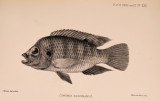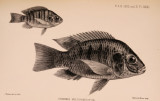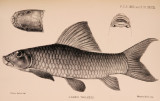| OCR Text |
Show 1 9 0 2 . ] SPIDERS FROM BORNEO AND SINGAPORE. 2 6 7 cephalothorax and a slender abdominal peduncle, so that the triple division of the insect-body is well imitated. The abdominal peduncle appears to bear a small scale and the abdomen is elongated ; the elbowed antenna? of an ant are mimicked by the anterior pair of legs of the spider. I have not been informed whether this species, like the preceding, lives in company with its models. VIII. CONVERGENT GROUPS. There are certain combinations of colours in distasteful or otherwise specially protected insects which may be considered as warning : such are, black with yellow bands, black with one broad red band, black with white tips to the wings, yellow or red with black spots, red elytra or wings more or less broadly tipped with black; and we find insects, belonging to the most diverse orders, with one or other of these combinations of colours converging to a central form, a typical distasteful insect. Some of these con-vergingforms may be non-immune and pseudaposematic (examples of Batesian mimicry); others may be distasteful themselves and synaposematic (examples of Mullerian mimicry). For example, all the Lycidfe are strongly distasteful, as I have proved by repeated experiments \ and large numbers of them show the same type of coloration, the anterior third or two-thirds of the elytra being red, the posterior two-thirds or third black, whilst the head and thorax are black or red. Resembling the members of this group are ten species of Longicorns, belonging to four subfamilies, one Clerid, two Hispids, two Elaters, one Rliipidocerid, one Eucnemid, or seventeen Coleoptera in all, one moth and several Hemiptera. The Lycidse, then, may be considered as distasteful insects which are characterized by a definite type of warning coloration, whilst the coloration of the insects which resemble them so closely can hardly be looked on as essentially typical of the groups to which the insects belong. The conspicuous Lycid, Lycostomus gestroi 5 , is mimicked by three Longicorns-Erythrus apiculatus var., E. rotundicollis and sterncdis, and by Eicrycepkahts lundi, by a moth, Phauda limbata, by at least four bugs, of which Ectalops rubiaceus and Serinetha abdominalis alone have been identified. The arrangement of colours in the Lycid Metriorrhynchus Jcirschi, in the Longicorns Ephies dilaticornis and Erythrus biapi-catus, in the Hispid Gonophora wallacei var., and in a Clerid of the genus Tenerus (T. sulcipennis (Gahan)) is almost identical. Calochromus dispar is mimicked by the LongicornsPyrestfes eximius and P. virgata, by a Rliipidocerid of the genus Ennornates, and by an unidentified Eucnemid. The Lycids Ditoneces sp. near fusci-cornis and Taphes brevicollis, the Lamiicl Longicorn Xyaste torrida, 1 A strong vitality is correlated with this distastefulness; I have seen a Lycid beetle walk away apparently uninjured after it had been well pecked by two or three fowls. The distasteful Endomychidse are also difficult to kill (cf. also vitality of UanaintB, Acrceince, and Heli'conince noted by various authors;. |
































































































































































































































































































































